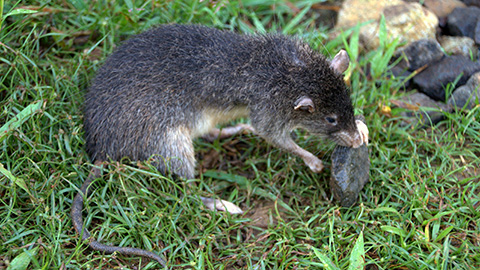Researcher Discovered a New Rat Species while Studying Monitor Lizards
Valter Weijola, a researcher from the University of Turku, discovered a large rat species unknown to science from Manus Island in Papua New Guinea. Weijola’s previous discovery from another island in the same island state, reported in late February, was a new monitor lizard species.

According to genetic research, the new rat species is one of the oldest living species within genus Rattus. These unusually large rats live in the rainforests of Manus Island and avoid contact with humans.
Researchers had previously discovered unidentified rat bones from an island north of Papua New Guinea. Since some of the bones were very old, the species was feared to be extinct.
In 2012, Weijola found the new rat species while studying monitor lizards on Manus Island for his dissertation. With help from the locals, Weijola found a rat from the rainforests in the middle of the island and it represented the same species as the bone discoveries.
‒ Before my arrival, I had read about the previous discoveries by accident, so I was aware of the possibility that the species might still be living on the island. When I got there, I learned that the locals catch big rats from time to time. We found signs of the existence of rats quite fast and eventually we found this particular specimen, explains Weijola.
The new rat species is easy to recognise due to its large size, short tail, and long and rough hair coat. The rat Weijola discovered was 26 centimetres in length when measured from nose to the base of the tail. There are 67 species in the genus Rattus and very few of them share their living area with humans like the Brown Rat (Rattus norvegius) and Black Rat (Rattus rattus) familiar to us.
An international team of scientists published the new discovery in the highly esteemed Journal of Mammalogy and named it Rattus detentus. The Latin word detentus, meaning someone who is detained, is a reference to the ancestor of the species that lived isolated on Manus Island.
‒ Over the course of history, various native species have lived exclusively on islands in the Pacific Ocean. Many of them have become either endangered or extinct due to humans and the new species they brought along with them. Therefore, the discovery of a native and robust species is both scientifically noteworthy and positive news, says Weijola.
The researchers from the Zoological Museum of the University of Turku are conducting fieldwork in different parts of the tropic and keep discovering species previously unknown to science. The discovery of this new rat species, however, is exceptionally remarkable.
‒ Majority of the animal species unknown to science are small. The discovery of a large native rat species by a young Finnish researcher is fantastic news and will hopefully draw attention to the fact how mysterious the diversity of nature still is, notes the Director of the Zoological Museum Ilari E. Sääksjärvi.

Valter Weijola studied the monitor lizards living on Manus Island for his dissertation in 2012.
Text: Jenni Valta
Photos: Valter Weijola
Translation: Saara Yli-Kauhaluoma